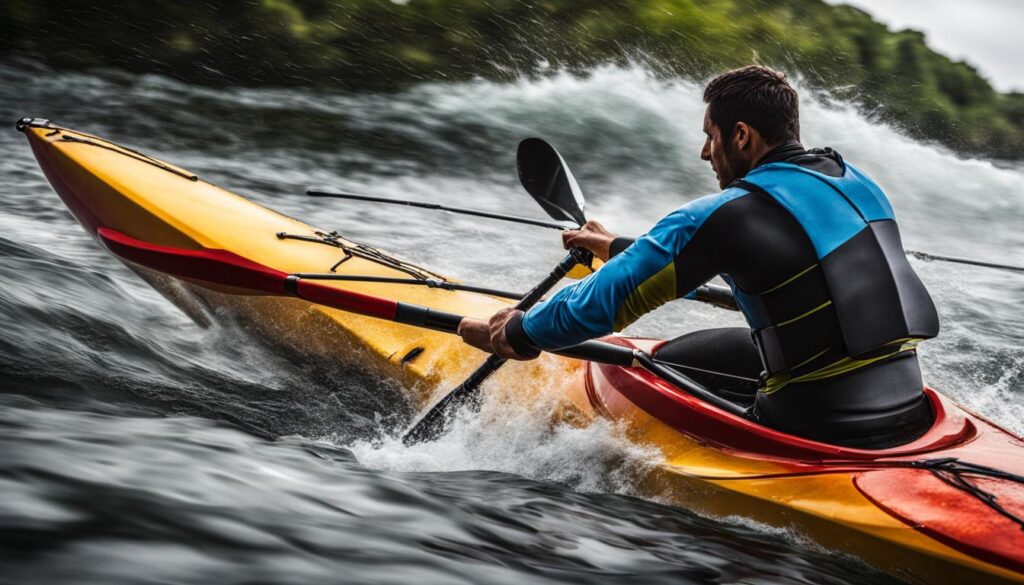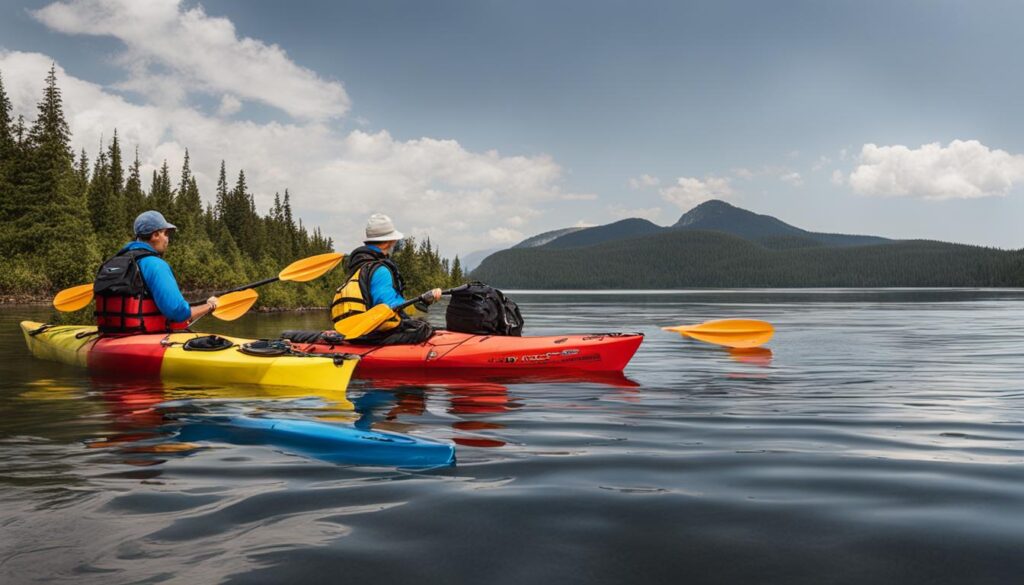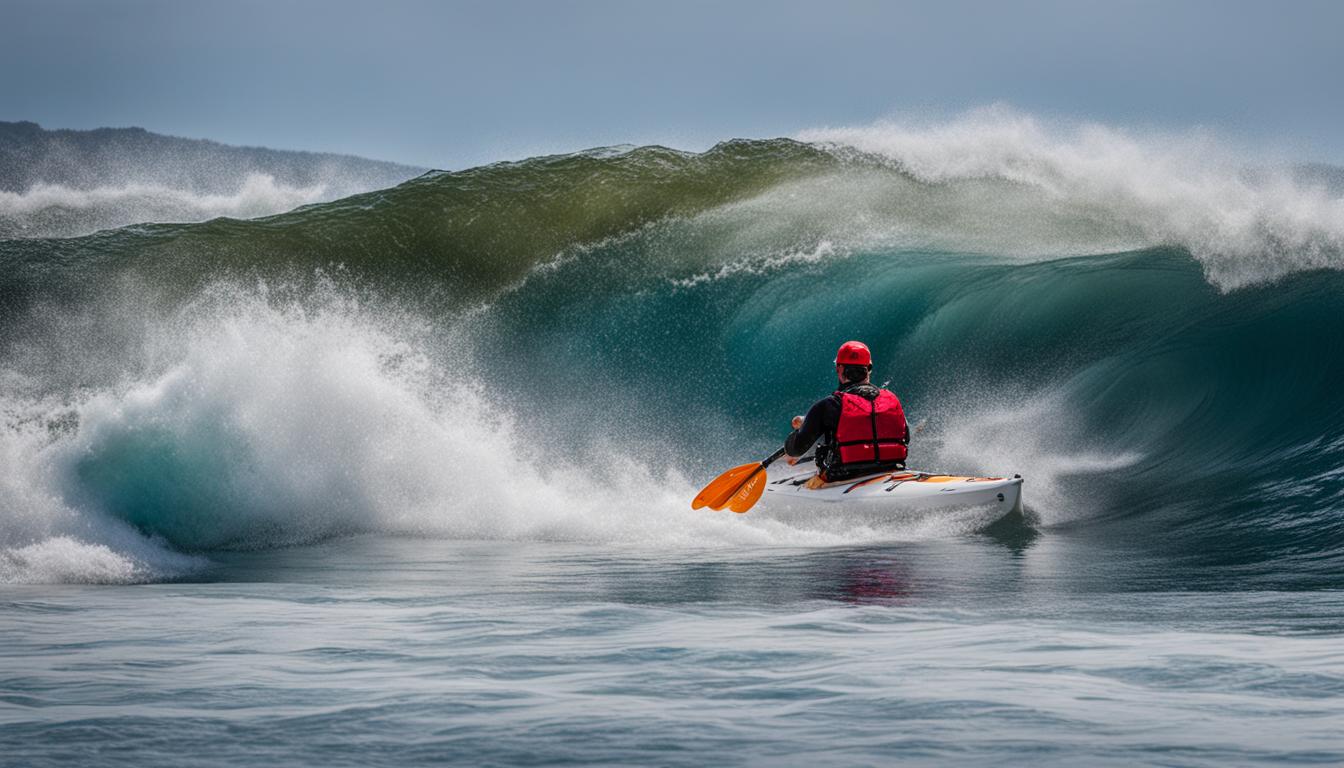Are you ready to take your kayaking skills to the next level? Kayaking in strong currents can be an exhilarating and challenging experience, but it requires proper technique, strategy, and a deep respect for the power of the river. In this section, we will provide you with valuable tips and strategies to help you navigate fast-moving water safely and confidently.
Key Takeaways:
- Mastering the proper paddling stroke is crucial for kayaking in strong currents.
- Engaging your core muscles and using proper form are essential for efficient paddling in fast water.
- Practice essential maneuvers such as the forward stroke, back paddling, ferrying, and pulling into and out of current.
- Learn how to read and respect the flow of the river to choose the right path and identify safe routes.
- Ensure you have the right gear, including a suitable kayak, paddle, PFD, and a waterproof dry bag.
Mastering the Paddle Stroke: Key to Success in Strong Currents
To paddle effectively in strong currents, it is crucial to utilize your core muscles instead of relying solely on your arms. The power and endurance in your paddle stroke should come from engaging your torso muscles and the rest of your body. This not only improves your paddling efficiency but also prevents fatigue and helps to maintain stability in fast-moving water. Developing the correct muscle memory and practicing good form are essential for mastering the paddle stroke.
When paddling in strong currents, focus on maintaining a proper form throughout each stroke. Start by firmly gripping the paddle with both hands, keeping your hands slightly wider than shoulder-width apart. As you push the paddle blade into the water, engage your core muscles and rotate your torso, generating power from your entire body. This allows you to transfer more energy into your stroke, resulting in increased speed and control.
| Paddle Stroke Technique | Description |
|---|---|
| Forward Stroke | Engage your core muscles and use a smooth, sweeping motion to propel the kayak forward. Keep the paddle close to the side of the kayak and exit the water near your feet. |
| Reverse Stroke | Use the reverse stroke to slow down or move backward. Push the paddle blade away from the kayak while maintaining a proper form, and exit the water near your feet. |
| Sweep Strokes | Perform sweep strokes by sweeping the paddle blade in an arc-shaped motion away from the kayak. This maneuver helps you turn quickly and navigate around obstacles. |
| Draw Strokes | To move the kayak sideways, use draw strokes. With the paddle blade slightly angled towards the kayak, pull the paddle towards your hip, generating a lateral force. |
Remember, the key to mastering the paddle stroke in strong currents is to practice regularly and focus on proper technique. As you develop your skills and build your core strength, you’ll become more confident and efficient in navigating fast-moving water. So grab your paddle, engage your core, and get ready to conquer the currents!

Quote:
“Paddling in strong currents requires not just arm strength, but also the engagement of your core muscles. By utilizing your entire body and practicing good form, you can paddle with power and endurance, ensuring a successful experience in fast-moving water.”
Essential Maneuvers for Strong Currents
When kayaking in strong currents, there are several essential maneuvers that you need to master to navigate the water successfully. These maneuvers will allow you to maintain control, change direction, and navigate obstacles with ease. Let’s take a closer look at each of these essential maneuvers:
Forward Stroke in Strong Currents
The forward stroke is the most fundamental and important paddling technique when kayaking in strong currents. It allows you to paddle against the current and make progress. To perform a strong forward stroke, engage your core muscles and use a combination of torso rotation and arm strength. Keep your paddle close to the kayak and use a smooth, steady motion to propel yourself forward.
Back Paddling in Fast Water
Back paddling is a crucial maneuver that helps you slow down, stop, or maneuver in crowded areas. To back paddle, simply reverse the forward stroke by pulling the paddle towards you instead of pushing it away. This will create a backward motion and provide you with the necessary control in fast-moving water.
Ferrying Across a River
Ferrying across a river involves crossing the current at an angle to avoid being swept downstream. This maneuver is particularly useful when you need to move from one side of the river to the other. To ferry, paddle at an angle upstream while keeping your kayak’s nose pointed towards the opposite shore. Adjust the angle and paddle strength to maintain your position and reach your desired destination.
Pulling Into and Out of Current
Pulling into and out of current, also known as the “peel out” and “eddy turn,” is essential for navigating obstacles and changing directions safely. This maneuver allows you to enter and exit eddies, which are calm pockets of water behind obstructions. To perform a peel out, paddle smoothly and steadily away from the eddy, using a combination of forward and sweep strokes. To execute an eddy turn, paddle into the eddy and use a combination of reverse and sweep strokes to turn your kayak around.
Mastering these essential maneuvers will greatly enhance your ability to navigate strong currents and ensure a safe and enjoyable kayaking experience. Practice these techniques in varying water conditions to build your skills and confidence on the water.
Reading and Respecting the Flow of the River
When kayaking in strong currents, it is crucial to understand how to read and respect the flow of the river. By observing and interpreting the characteristics of flowing water, you can make informed decisions about choosing the right path and identifying safe routes.
One key aspect of reading flowing water is paying attention to its speed and direction. Observe the movement of the currents and look for visual cues such as ripples and V-shaped trails. These indicators can give you insights into the volume and force of the water. The bigger the V-shaped trail, the more water is causing it and the safer it is to aim for. Use these visual cues to guide your navigation through the strong currents.
Remember, a river is a dynamic environment that constantly changes, so always stay vigilant and adapt to any modifications in the flow as you paddle. Your ability to read flowing water will improve with experience, so take the time to learn and practice this essential skill.
Choosing the Right Path
When faced with multiple channels or obstacles in the river, choosing the right path becomes crucial. Look for areas with slower-moving water or eddies, which can provide a temporary respite from the strong currents. These eddies can serve as safe spots for regaining control and planning your next moves.
Additionally, be aware of potential hazards such as submerged rocks or strainers (tree branches or debris). Avoid narrow channels or areas with powerful constrictions, as they can intensify the strength of the current and make navigation more challenging.
Understanding Water Flow
Understanding how water flows is essential for navigating strong currents. Remember that water follows the path of least resistance, so look for areas without obstacles or obstructions where the current may be weaker. These areas can provide easier and safer passage, allowing you to conserve energy and maintain control over your kayak.
Take note of how the current interacts with various features in the river, such as rocks or changes in riverbed elevation. These features can create eddies, boils, or other hydraulic effects that affect the flow of water. Understanding these dynamics will help you anticipate how the currents will behave and make more informed decisions.
| Flow Characteristics | Interpretation |
|---|---|
| Ripples | Shallow and fast-moving water |
| V-Shaped Trails | Indicates the direction and force of the current |
| Eddies | Slower-moving water and potential safe spots |
| Hydraulic Effects | Interactions between water and river features |
By honing your ability to read and respect the flow of the river, you can confidently navigate strong currents and enjoy the thrill of kayaking in challenging water conditions.
Gear Up for Strong Currents: Essential Equipment for Kayaking
When it comes to kayaking in strong currents, having the right equipment can make all the difference in ensuring your safety and enjoyment. From choosing the right kayak to selecting the perfect paddle, here are some essential pieces of gear you’ll need for a successful kayaking adventure.
Choosing the Right Kayak
When selecting a kayak for strong currents, opt for a polyethylene rotomolded kayak. These kayaks offer the ideal balance of maneuverability, durability, and stability, making them well-suited for recreational purposes. The polyethylene material ensures that your kayak can withstand the challenges of fast-moving water while providing stability to keep you upright.
Selecting a Paddle
The paddle you choose plays a vital role in your kayaking experience. It’s important to choose a paddle that matches the width of your kayak and the measurement of your torso. This ensures optimal paddling efficiency and reduces the risk of strain or fatigue during your journey. Consider investing in a lightweight and durable paddle made from materials like carbon fiber or fiberglass for enhanced performance.
The Importance of a PFD (Personal Flotation Device)
A Personal Flotation Device, or PFD, is a crucial piece of equipment that should never be overlooked. Ensure that your PFD fits properly and provides ample buoyancy to keep you afloat in case of any unexpected circumstances. Look for a PFD that is comfortable to wear and allows for easy movement while providing maximum safety.
The Need for a Dry Bag
When kayaking in strong currents, there’s always the possibility of water entering your kayak. To keep your essentials and valuables dry, invest in a waterproof dry bag. These bags are designed to keep your belongings safe and dry, even in wet conditions. Look for a dry bag with a secure closure system and ample storage space to accommodate your gear.

By ensuring that you have the right gear for kayaking in strong currents, you can embark on your adventure with confidence. Remember to choose a kayak that offers stability and maneuverability, select a paddle that suits your needs, wear a properly fitting PFD, and keep your gear dry with a waterproof dry bag. With the right equipment, you’ll be well-prepared to take on the challenge of paddling in fast-moving water and enjoy an exhilarating kayaking experience.
Mastering Basic Paddle Strokes for Currents
When kayaking in strong currents, mastering basic paddle strokes is crucial for maintaining control, maneuvering effectively, and staying safe. By understanding the correct paddle grip and technique, you can navigate through fast-moving water with confidence and precision.
Correct Paddle Grip and Technique
The foundation of successful kayaking in strong currents starts with the correct paddle grip and technique. Hold the paddle with a shoulder-length grip, ensuring your hands are positioned slightly wider than shoulder-width apart. This grip allows for optimal control and power during each stroke.
Focus on engaging your core muscles and using proper form throughout your paddle stroke. Start by planting the blade in the water next to your toes, and then pull the blade through the water, exerting force with your torso and core rather than solely relying on your arms. This technique will maximize your efficiency and prevent fatigue in fast-moving water.
Forward Stroke
The forward stroke is the foundation of kayaking and essential for paddling in strong currents. To execute a proper forward stroke, rotate your torso with each stroke, engaging your core muscles for power and stability. Reach forward with the blade, and pull it through the water in a straight line, maintaining a steady rhythm. This stroke propels the kayak forward, enabling you to make progress against the current.
Reverse Stroke
The reverse stroke is useful for moving backward and slowing down in strong currents. To perform a reverse stroke, reach behind you with the paddle blade, submerging it in the water, and pull the blade towards you. Use your core muscles to generate power and control the kayak’s backward movement. Mastering the reverse stroke is crucial for maintaining stability and maneuverability in fast water.
Sweep Strokes and Draw Strokes
Sweep strokes and draw strokes are essential for turning the kayak and moving sideways in strong currents. A sweep stroke involves starting the stroke near the bow or stern of the kayak and sweeping the blade in an arc away from the kayak. This stroke allows you to turn the kayak smoothly and effectively.
Draw strokes, on the other hand, are used for moving the kayak sideways. To execute a draw stroke, place the blade perpendicular to the kayak’s side and pull it towards you. This stroke creates a sideways movement, allowing you to maneuver in tight spaces or adjust your position in the current.
Practice each paddle stroke with proper form and focus on using your torso and core muscles to generate power and maintain stability. By mastering these basic paddle strokes, you’ll be well-equipped to navigate strong currents and enjoy the thrill of fast water paddling.
Conclusion
Mastering kayaking in strong currents is a journey that requires both skill-building and safety awareness. By understanding the proper paddle stroke and utilizing your core muscles, you can navigate through fast-moving water with precision and efficiency.
Learning essential maneuvers such as the forward stroke, back paddling, ferrying, and pulling into and out of current will help you maneuver through challenging river conditions. Reading and respecting the flow of the river is crucial for identifying safe routes and choosing the right path. With experience, you’ll develop the ability to read the water accurately.
Gearing up with the right equipment, including a suitable kayak, paddle, PFD, and a waterproof dry bag, ensures your safety and enhances your enjoyment of fast water paddling. Remember to prioritize safety by wearing a well-fitted PFD at all times.
Mastering kayaking in strong currents not only provides an adrenaline-pumping thrill but also builds your stamina and skills. So, go ahead and embrace the excitement of navigating through fast-moving water while continuing to develop your kayaking expertise.
FAQ
What are some tips for kayaking in strong currents?
To kayak effectively in strong currents, engage your core muscles and utilize proper form. It is important to practice good paddle stroke technique and respect the power of moving water.
Why is engaging core muscles important in paddling in strong currents?
Engaging your core muscles helps generate power and endurance in your paddle stroke, making your paddling more efficient. It also prevents fatigue and helps maintain stability in fast-moving water.
What are some essential maneuvers for navigating strong currents?
Mastering the forward stroke, back paddling, ferrying, and pulling into and out of current are crucial maneuvers for successfully navigating strong currents. These techniques help you paddle against the current, slow down or maneuver in crowded areas, cross the current at an angle, and navigate obstacles safely.
How can I read and respect the flow of the river when kayaking in strong currents?
Pay attention to the speed and direction of water flow, and look for visual cues like ripples and V-shaped trails. The bigger the V-shaped trail, the safer it is to aim for. Choose your path wisely by considering the volume of water and the obstacles ahead.
What gear do I need for kayaking in strong currents?
Choose a kayak suitable for strong currents, such as a polyethylene rotomolded kayak, for maneuverability, durability, and stability. Select a paddle that matches the width of your kayak and your torso measurement. Always wear a properly fitting Personal Flotation Device (PFD) and use a waterproof dry bag to protect your essentials and valuables.
What are the basic paddle strokes I need to master for kayaking in strong currents?
The basic paddle strokes include the forward stroke, reverse stroke, sweep strokes, and draw strokes. Each stroke serves a specific purpose in propelling, turning, and maneuvering your kayak. Practice each stroke with proper form and use your core muscles to generate power and maintain stability.
How can I enjoy kayaking in strong currents while prioritizing safety?
Mastering the paddle stroke, learning essential maneuvers, and understanding how to read and respect the flow of the river will help you navigate strong currents safely. Always prioritize safety by wearing a properly fitting PFD and choosing the right gear. With experience and skill-building, you can enjoy the thrill of kayaking in fast-moving water.





